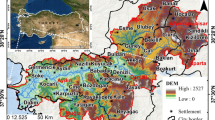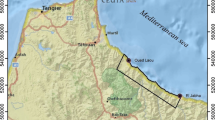Abstract
This study aims to investigate the performances of different training algorithms used for an artificial neural network (ANN) method to produce landslide susceptibility maps. For this purpose, Ovacık region (southeast of Karabük Province), located in the Western Black Sea Region (Turkey), was selected as the study area. A total of 196 landslides were mapped, and a landslide database was prepared. Topographical elevation, slope angle, aspect, wetness index, lithology, and vegetation index parameters were taken into account for the landslide susceptibility analyses. Two different ANN structures, which were composed of single and double hidden layers, were applied to compare the effects of the ANN. Four different training algorithms, namely batch back-propagation, quick propagation, conjugate gradient descent (CGD), and Levenberg–Marquardt, were used for the training stage of the ANN models. Thus, eight different landslide susceptibility maps were produced for the study area using different ANN structures and algorithms. In order to assess the effects and spatial performances of the considered training algorithms on the ANN models, the relative operating characteristics (ROC) and relation value (rij) approaches were used. The susceptibility map produced by CGD1 has the highest AUC (0.817) and rij values (0.972). Comparison of the susceptibility maps indicated that CGD training algorithm is the slowest one among the other algorithms, but this algorithm showed the highest performance on the results.






Similar content being viewed by others
References
Aleotti P, Chowdhury R (1999) Landslide hazard assessment: summery review and new perspective. Bull Eng Geol Env 58(1):28–44
Alimohammadlou Y, Najafi A, Gokceoglu C (2014) Estimation of rainfall-induced landslides using ANN and fuzzy clustering methods: a case study in Saeen Slope, Azerbaijan province, Iran. Catena 120:149–162
Arnone E, Francipane A, Scarbaci A, Puglisi C, Noto LV (2016) Effect of raster resolution and polygon-conversion algorithm on landslide susceptibility map**. Env Model and Software 84:467–481
Ayalew L, Yamagishi H, Marui H, Kanno T (2005) Landslides in Sado Island of Japan: part II. GIS-based susceptibility map** with comparisons of results from two methods and verifications. Eng Geol 81(4):432–445
Begueira S (2006) Validation and evaluation of predictive models in hazard assessment and risk management. Nat Haz 37:315–329
Beven KJ, Kirkby MJ (1979) A physically based, variable contributing area model of basin hydrology. Hydrol Sci Bull 24:43–69
Bui DT, Pradhan B, Lofman O, Revhaug I, Dick OB (2012) Landslide susceptibility assessment in the Hoa Binh province of Vietnam: a comparison of the Levenberg–Marquardt and Bayesian regularized neural networks. Geomorphology 171–172:12–29
Chen J, Zenga Z, Jiang P, Tang H (2015) Deformation prediction of landslide based on functional network. Neurocomputing 149:151–157
Choi J, Oh H, Won J, Lee S (2010) Validation of an artificial neural network model for landslide susceptibility map**. Env Earth Sci 60:473–483
Choi J, Oh H-J, Lee H-J, Lee C, Lee S (2012) Combining landslide susceptibility maps obtained from frequency ratio, logistic regression, and artificial neural network models using ASTER images and GIS. Eng Geol 124:12–23
Conforti M, Pascale S, Robustelli G, Sdao F (2014) Evaluation of prediction capability of the artificial neural networks for map** landslide susceptibility in the Turbolo River catchment (northern Calabria, Italy). CATENA 113:236–250
Dagdelenler G, Nefeslioglı HA, Gokceoglu C (2015) Modification of seed cell sampling strategy for landslide susceptibility map**: an application from the Eastern part of the Gallipoli Peninsula (Canakkale, Turkey). Bull Eng Geol Env 75:575–590
Das HO, Sonmez H, Gokceoglu C, Nefeslioglu HA (2013) Influence of seismic acceleration on landslide susceptibility maps: a case study from NE Turkey (the Kelkit Valley). Landslides 10:433–454
Ding L, Matthews J (2009) A contemporary study into the application of neural network techniques employed to automate CAD/CAM integration for 130 die manufacture. Comput Ind Eng 57:1457–1471
Ercanoglu M (2005) Landslide susceptibility assessment of SE Bartin (West Black Sea region, Turkey) by artificial neural networks. Nat Haz Earth Sys Sci 5:979–992
Ercanoglu M, Dagdelenler G, Ozsayın E, Alkevli T, Sonmez H, Ozyurt NN, Kahraman B, Ucar İ, Cetinkaya S (2016) Application of Chebyshev theorem to data preparation in landslide susceptibility map** studies: an example from Yenice (Karabuk, Turkey) region. J Mt Sci 13(11):1923–1940
Ermini L, Catani F, Casagli N (2005) Artificial Neural Networks applied to landslide susceptibility assessment. Geomorphology 66:327–343
Fahlman SE (1988) Faster-Learning Variations on Back-Propagation: An Empirical Study. In Proceedings of the 1988 Connectionist Models Summer School, Morgan Kaufmann, pp 1–17
Fell R, Corominas J, Bonnard C, Cascini L, Leroi E, Savage WZ (2008) Guidelines for landslide susceptibility, hazard and risk zoning for land-use planning. Eng Geol 102:99–111
García-Rodríguez MJ, Malpica JA (2010) Assessment of earthquake-triggered landslide susceptibility in El Salvador based on an artificial neural network model. Nat Haz Earth Sys Sci 10:1307–1315
Glade T, Crozier MJ (2005) Landslide hazard and risk—Concluding comment and perspectives. In: Glade T, Anderson M, Crozier M (eds) Landslide hazard and risk. Wiley, Chichester, pp 767–774
Gomez H, Kavzoglu T (2005) Assessment of shallow landslide susceptibility using artificial neural networks in Jabonosa River Basin, Venezuela. Eng Geol 78:11–27
Gorum T, Gonencgil B, Gokceoglu C, Nefeslioglu H (2008) Implementation of reconstructed geomorphologic units in landslide susceptibility map**: the Melen Gorge (NW Turkey). Nat Haz 46(3):323–351
Guzzetti F, Reichenbach P, Ardizzonne F, Cardinali M, Galli M (2006) Estimating the quality of landslide susceptibility models. Geomorphology 81:166–184
Hagan MT, Menhaj MB (1994) Training feedforward networks with the Marquardt algorithm. IEEE Trans Neural Netw 5:989–993
Hagan MT, Demuth HB, Beale MH (1996) Neural network design. PWS, Boston
Hasekiogullari GD, Ercanoglu M (2012) A new approach to use AHP in landslide susceptibility map**: a case study at Yenice (Karabuk, NW Turkey). Nat Haz 63:1157–1179
Hestenes MR, Stiefel E (1952) Methods of conjugate gradients for solving linear systems. J Res Natl Bur Stand 49:2379
Kanungo D, Arora M, Sarkar S, Gupta R (2006) A comparative study of conventional, ANN black box, fuzzy and combined neural and fuzzy weighting procedures for landslide susceptibility zonation in Darjeeling. Eng Geol 85:347–366
Kawabata D, Bandidas J (2009) Landslide susceptibility map** using geological data, a DEM from ASTER images and an Artificial Neural Network (ANN). Geomorphology 113:97–109
Lan HX, Zhou CH, Wang LJ, Zhang HY, Li RH (2004) Landslide hazard spatial analysis and prediction using GIS in the **aojiang watershed, Yunnan, China. Engineering Geology 76(1–2):109–128
Lasko TA, Bhagwat JG, Zou KH, Ohno-Machado L (2005) The use of receiver operating characteristic curves in biomedical informatics. J Biomed Inform 38(5):404–415
Lee CF, Ye H, Yeung MR, Shan X, Chen G (2001) AIGIS-based methodology for natural terrain landslide susceptibility map** in Hong Kong. Episodes 24(3)
Lee S, Ryu J-H, Min K, Won J-S (2003) Landslide susceptibility analysis using GIS and artificial neural network. Earth Surf Proc Landf 28:1361–1376
Lee S, Ryu J-H, Min K, Won J-S, Park H-J (2004) Determination and application of the weights for landslide susceptibility map** using an artificial neural network. Eng Geol 71:289–302
Li Y, Chen G, Zhou G, Zheng I (2012) Rainfall and earthquake-induced landslide susceptibility assessment using GIS and Artificial Neural Network. Nat Haz Earth Syst Sci 12:2719–2729
Lippmann R (1987) An introduction to computing with neural nets. ASSP Mag, IEEE
McCulloch WS, Pitts W (1990) A logical calculus of the ideas immanent in nervous activity. Bull Math Biol 52(1/2):99–115
MTA (2002) Geological map of Turkey. General directorate of mineral research and exploration, Ankara
Nadim F, Kjekstad O, Peduzzi P, Herold C, Jaedicke C (2006) Global landslide and avalanche hotspots. Landslides 3(2):159–174
Nauck D, Klawonn F, Kruse R (1997) Foundations of neuro-fuzzy systems. Wiley, New York. ISBN 0471971510
Nefeslioglu HA, Gokceoglu C, Sonmez H (2008) An assessment on the use of logistic regression and artificial neural networks with different sampling strategies for the preparation of landslide susceptibility maps. Eng Geol 97(3/4):171–191
Park S, Choi C, Kim B, Kim J (2013) Landslide susceptibility map** using frequency ratio, analytic hierarchy process, logistic regression, and artificial neural network methods at the Inje area, Korea. Env Earth Sci 68:1443–1464
Pradhan B, Lee S (2007) Utilization of optical remote sensing data and GIS tools for regional landslide hazard analysis by using an artificial neural network model. Earth Sci Front 14(6):143–152
Pradhan B, Lee S, Buchroithnera MF (2010) A GIS-based back-propagation neural network model and its cross-application and validation for landslide susceptibility analyses. Comput Environ Urban Syst 34:216–235
Ramakrishnan D, Singh TN, Verma AK, Gulati A, Tiwari KC (2013) Soft computing and GIS for landslide susceptibility assessment in Tawaghat area, Kumaon Himalaya, India. Nat Haz 65:315–330
Romer C, Ferentinou M (2016) Shallow landslide susceptibility assessment in a semiarid environment- A Quaternary catchment of KwaZulu-Natal, South Africa. Eng Geol 201:29–44
Rosenblatt F (1958) Theperceptron: aprobabilistic model for information storage and organization in the brain. Psychol Rev 6:386–408
Ross TJ (1995) Fuzzy logic with engineering applications. Mc-Graw-Hill, New Mexico
Rumelhart D, Hinton G, Williams R (1985) Learning internal representations by error propagation. ICS Report 8506
Sejnowski T, Rosenberg C (1987) Parallel networks that learn to pronounce English text. Comp Syst 1(1):145–168
Shanthi D, Sahoo G, Saravanan N (2009) Evolving connection weights of artificial neural networks using genetic algorithm with application to the prediction of stroke disease. Int J Soft Comput 4:95–102
Sooters R, Van Westen CJ (1996) Slope stability recognition analysis and zonation. In: Turner AK, Schuster RI (eds) Landslides: investigation and mitigation, transportation research board special report 247. National Academy Press Washington DC 129–177 pp
Suzen ML, Doyuran V (2004) Data driven bivariate landslide susceptibility assessment using geographical information systems: a method and application to Asarsuyu catchment, Turkey. Eng Geol 71:303–321
Sweet JA (1988) Measuring the accuracy of diagnostic systems. Science 240:1285–1293
Timur E, Aksay A (2002) 1/100.000 scaled geological maps of Turkey, Zonguldak F29 Quadrangle. MTA Institution Publication
Van Den Eeckhaut M, Hervás J (2012) State of the art of national landslide databases in Europe and their potential for assessing landslide susceptibility, hazard and risk. Geomorphology 139–140:545–558
Varnes DJ (1978) Slope movement, types and processes. In: Schuster RL, Krizek RJ (eds) Landslides, analysis and control, special report 176: Transportaion research board. National Academy of Sciences, Washington DC, pp 11–33
Wu X, Niu R, Ren F, Peng L (2013) Landslide susceptibility map** using rough sets and backpropagation neural networks in the Three Gorges, China. Env Earth Sci 70:1307–1318
Yesilnacar E, Topal T (2005) Landslide susceptibility map**: a comparison of logistic regression and neural networks methods in a medium scale study, Hendek region (Turkey). Eng Geol 79:251–266
Yilmaz I (2009a) Landslide susceptibility map** using frequency ratio, logistic regression, artificial neural networks and their comparison: a case study from Kat landslides (Tokat-Turkey). Comp and Geosci 35:1125–1138
Yilmaz I (2009b) Comparison of landslide susceptibility map** methodologies for Koyulhisar, Turkey: conditional probability, logistic regression, artificial neural networks, and support vector machine. Env Earth Sci 61:821–883
Yilmaz I (2010) The effect of the sampling strategies on the landslide susceptibility map** by conditional probability and artificial neural networks. Env Earth Sci 60:505–519
Zare M, Pourghasemi HR, Vafakhah M, Pradhan B (2013) Landslide susceptibility map** at Vaz Watershed (Iran) using an artificial neural network model: a comparison between multilayer perceptron (MLP) and radial basic function (RBF) algorithms. Arab J Geosci 6:2873–2888
Acknowledgements
This research was supported by Hacettepe University Scientific Researches Coordination Section (Project No: 735). The authors would also like to thank Mr. Alphan Haktanır and Mr. Arda Öncü for their logistic support during the field studies.
Author information
Authors and Affiliations
Corresponding author
Rights and permissions
About this article
Cite this article
Can, A., Dagdelenler, G., Ercanoglu, M. et al. Landslide susceptibility map** at Ovacık-Karabük (Turkey) using different artificial neural network models: comparison of training algorithms. Bull Eng Geol Environ 78, 89–102 (2019). https://doi.org/10.1007/s10064-017-1034-3
Received:
Accepted:
Published:
Issue Date:
DOI: https://doi.org/10.1007/s10064-017-1034-3




